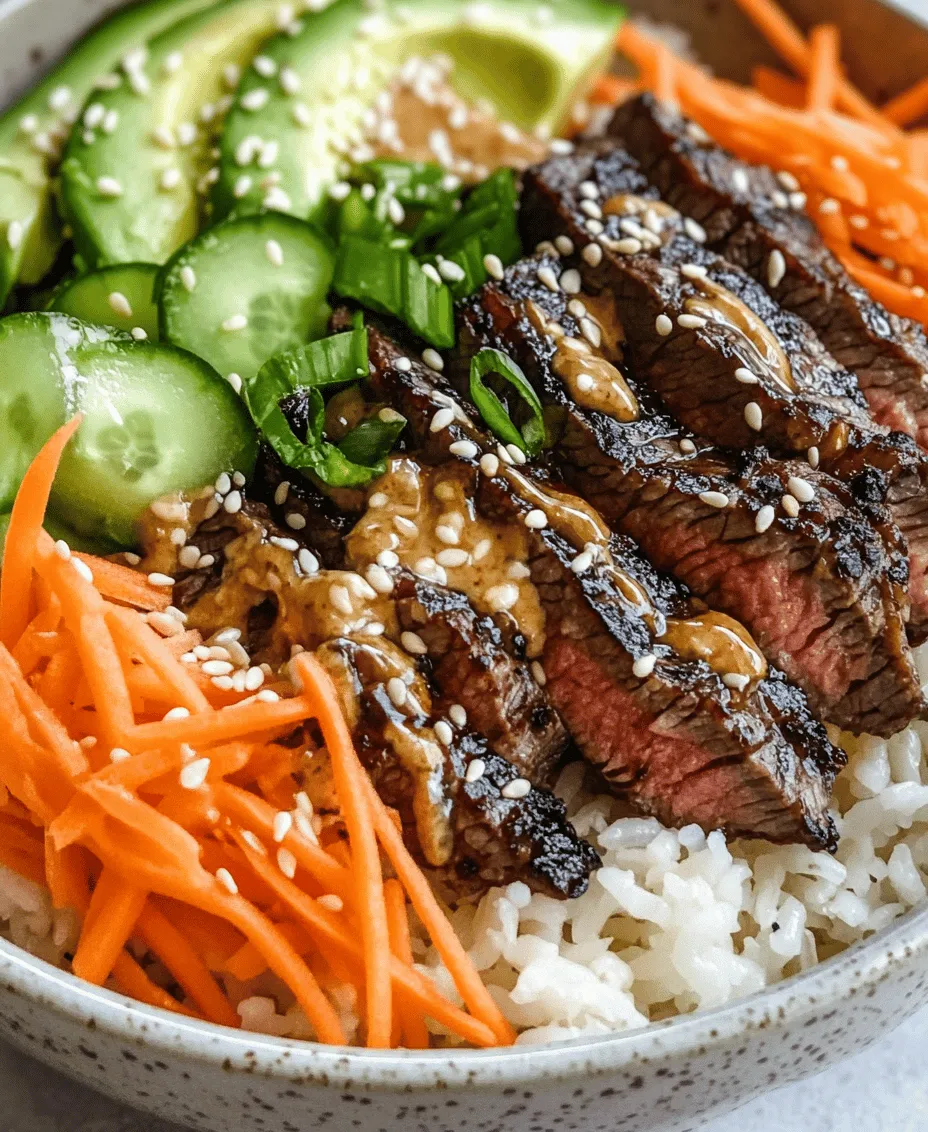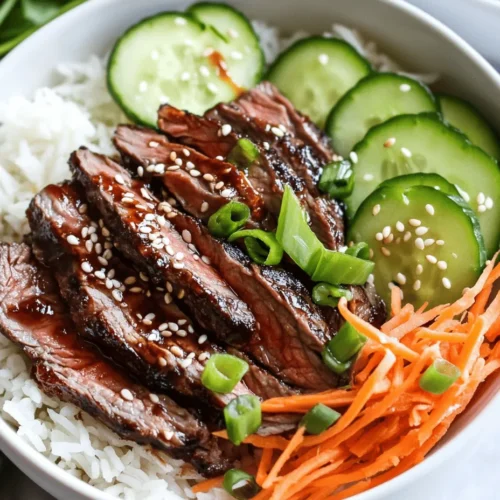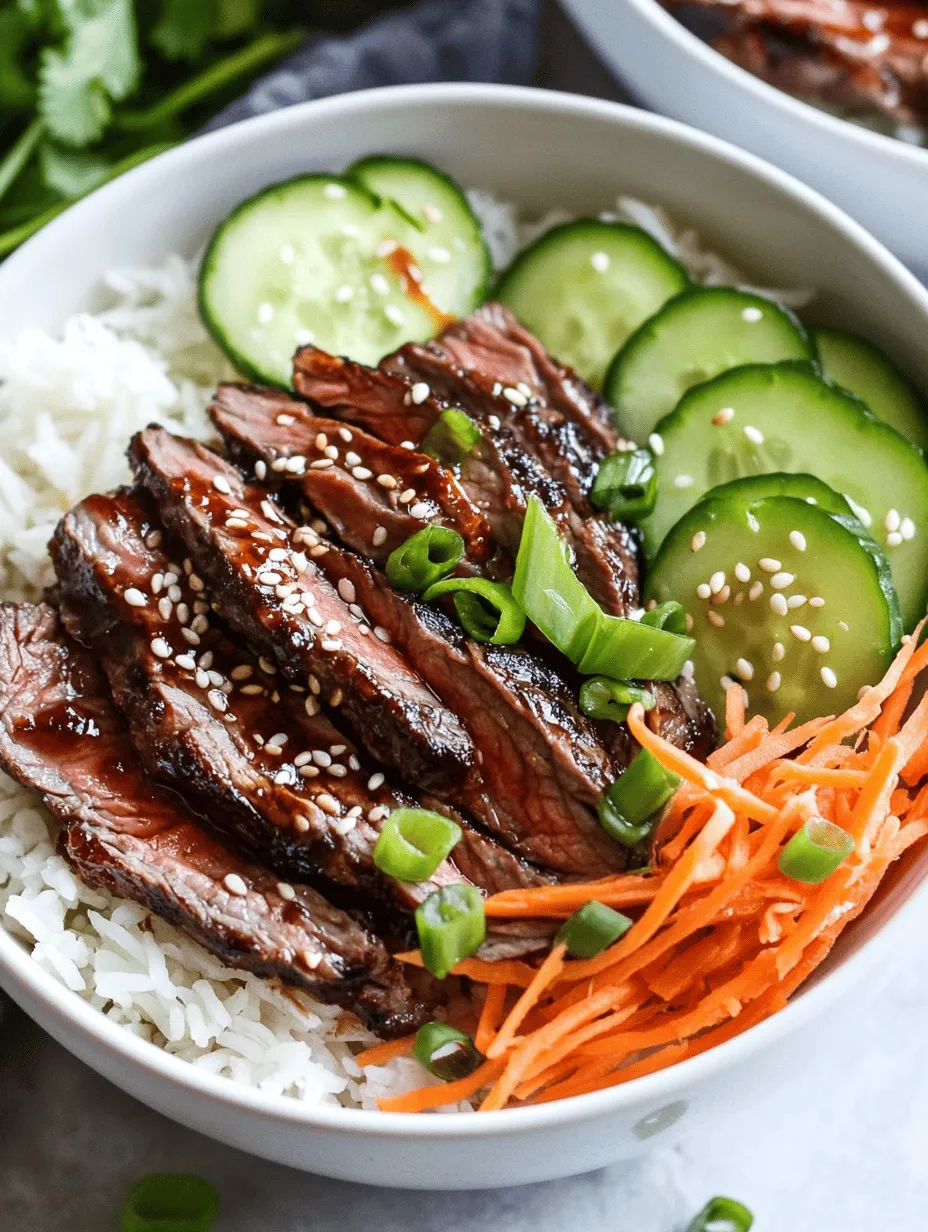Introduction
Discover the vibrant flavors of Korean cuisine with our Korean BBQ Steak Rice Bowls featuring a spicy cream sauce that elevates this dish to new heights. This recipe not only brings the rich umami of marinated steak to your table but also offers a colorful medley of fresh vegetables, making it a balanced and satisfying meal. It’s an ideal choice for weeknight dinners or meal prep, allowing you to enjoy a hearty and flavorful dish that is sure to impress family and friends alike.
Korean BBQ, known for its unique preparation and grilling methods, is a beloved culinary tradition. In this dish, we honor that tradition by marinating the steak, ensuring that every bite is packed with flavor. The addition of a spicy cream sauce adds an exciting twist, offering a creamy texture that beautifully complements the savory notes of the meat and vegetables. As you explore this recipe, you’ll learn not just how to prepare these delicious rice bowls, but also gain insight into the cultural significance behind each ingredient and preparation step.
Understanding Korean BBQ Culture
Korean BBQ is more than just a meal; it’s a social event that encourages communal dining and interaction. Traditionally, diners gather around a grill embedded in the table, where they can cook their own meats and vegetables to perfection. This interactive style promotes a sense of togetherness, making Korean BBQ a popular choice for celebrations and gatherings.
At the heart of Korean BBQ lies the marinade, a crucial element that enhances the flavors of the meat. Common ingredients in Korean marinades include soy sauce, sesame oil, garlic, and sugar, which work together to create a balance of savory, sweet, and umami flavors. The marinating process not only infuses the meat with these rich flavors but also helps to tenderize it, resulting in a juicy and flavorful bite.
Rice bowls are a staple in Korean dining, often serving as a base for various toppings, including grilled meats, vegetables, and sauces. They provide a hearty foundation that complements the flavorful ingredients layered on top. Incorporating rice into this dish not only makes it filling but also helps to balance out the spiciness of the cream sauce.
The Key Ingredients Explained
To achieve the best possible flavor and texture in your Korean BBQ Steak Rice Bowls, selecting the right ingredients is essential. Two popular cuts of beef commonly used in Korean cuisine are flank steak and ribeye, each bringing its own unique characteristics to the table.
Flank Steak vs. Ribeye
Flank steak is a lean cut taken from the abdominal muscles of the cow. It has a rich beefy flavor and is best suited for marinating due to its fibrous texture. When cooked properly, flank steak can be incredibly tender and juicy, making it a favorite for dishes like bulgogi.
On the other hand, ribeye is known for its marbling, which renders it incredibly flavorful and tender as it cooks. The higher fat content in ribeye adds a buttery richness that can elevate any dish. While both cuts are excellent choices for marinating and grilling, your preference may vary depending on the desired flavor and texture in your rice bowl.
The Significance of Each Ingredient in the Marinade
The marinade is the star of the show when it comes to flavoring the steak. A well-crafted marinade for Korean BBQ typically includes:
– Soy Sauce: This staple ingredient provides a salty, umami-rich base.
– Brown Sugar: Adds a touch of sweetness that balances the saltiness of the soy sauce and helps with caramelization during grilling.
– Garlic: Freshly minced garlic infuses the steak with aromatic goodness.
– Sesame Oil: Contributes a nutty flavor that is characteristic of many Korean dishes.
– Mirin or Rice Wine: Offers a slight sweetness and acidity, enhancing the overall flavor profile.
Each component plays a vital role in creating a harmonious marinade that will deeply flavor your steak.
Introduction to Gochujang and Its Flavor Profile
One of the most distinctive ingredients in Korean cuisine is gochujang, a fermented red chili paste made from gochugaru (Korean chili powder), glutinous rice, fermented soybeans, and salt. Gochujang provides a unique flavor profile that is spicy, sweet, and slightly smoky. Its depth of flavor makes it an ideal addition to marinades and sauces, elevating the dish beyond mere heat.
In our spicy cream sauce, gochujang serves as the key ingredient that adds a kick to the creaminess, making it a delightful contrast to the savory steak.
Nutritional Benefits of the Chosen Vegetables
Accompanying the steak in this dish are vibrant vegetables that not only add color but also contribute nutritional value. Common vegetables used in Korean BBQ rice bowls include:
– Carrots: Rich in beta-carotene and antioxidants, carrots add a subtle sweetness and crunch.
– Bell Peppers: Available in various colors, bell peppers are high in vitamins A and C, providing a fresh and crisp texture.
– Cucumbers: Hydrating and low in calories, cucumbers add a refreshing element to balance the rich flavors of the steak and sauce.
– Green Onions: These aromatic herbs introduce a mild onion flavor that enhances the overall dish.
Incorporating a variety of vegetables not only enhances the visual appeal but also ensures a well-rounded meal with essential nutrients.
Marinating the Steak: The Foundation of Flavor
Now that we have a solid understanding of the cultural significance and ingredients, it’s time to dive into the marinating process, which is vital for infusing the steak with flavor.
Step-by-Step Guide to Creating the Marinade
1. Gather Your Ingredients: Collect all necessary ingredients for the marinade, including soy sauce, brown sugar, minced garlic, sesame oil, mirin (or rice wine), and gochujang.
2. Mix the Marinade: In a mixing bowl, combine 1/4 cup of soy sauce, 2 tablespoons of brown sugar, 2 cloves of minced garlic, 1 tablespoon of sesame oil, 1 tablespoon of mirin, and 1 tablespoon of gochujang. Whisk the ingredients together until well blended.
3. Prepare the Steak: Trim any excess fat from your chosen cut of steak (flank steak or ribeye) and slice it against the grain into thin strips. This ensures maximum tenderness when cooked.
4. Marinate the Steak: Place the sliced steak into a zip-top bag or a shallow dish and pour the marinade over it. Seal the bag or cover the dish, making sure the steak is fully coated in the marinade.
5. Refrigerate: Allow the steak to marinate in the refrigerator for at least 30 minutes, but for optimal flavor, aim for 2 to 4 hours. If you have the time, marinating overnight will yield even more tender and flavorful results.
Importance of Marinating Time for Flavor Infusion
Marinating is a crucial step that cannot be overlooked. The marinade needs time to penetrate the meat fibers, allowing the flavors to meld and develop. The acid from the marinade helps to break down the proteins, resulting in a more tender steak. However, be cautious not to exceed 24 hours, as prolonged marination can lead to a mushy texture.
Tips for Selecting the Best Steak Cuts for Marinating
When choosing your steak for Korean BBQ rice bowls, consider the following tips:
– Look for Quality: Choose steaks with good marbling, as the fat content will enhance the flavor and tenderness of the cooked meat.
– Freshness: Opt for fresh cuts rather than pre-packaged meats, as freshness directly impacts the taste.
– Thickness: Thinner cuts allow for quicker cooking and better absorption of the marinade. Aim for slices around 1/4 inch thick for optimal results.
With the steak marinating, the next step in our Korean BBQ Steak Rice Bowls is to craft the spicy cream sauce that will tie all the flavors together.
Crafting the Spicy Cream Sauce
The spicy cream sauce is a delightful addition that complements the savory marinated steak while providing an extra layer of flavor. This sauce is versatile, allowing you to adjust the spice levels according to your taste.
Detailed Recipe for the Sauce
1. Gather Ingredients: For the spicy cream sauce, you will need 1/2 cup of sour cream or Greek yogurt, 2 tablespoons of gochujang, 1 tablespoon of lime juice, 1 teaspoon of garlic powder, and salt to taste.
2. Mix the Ingredients: In a bowl, combine the sour cream or Greek yogurt with the gochujang, lime juice, and garlic powder. Stir until all ingredients are well incorporated.
3. Adjust Spice Levels: Taste the sauce and adjust the spice level as needed. If you prefer a milder sauce, reduce the amount of gochujang. For those who enjoy a kick, feel free to add more.
4. Refrigerate: Allow the sauce to chill in the refrigerator for at least 15 minutes to let the flavors meld. This step enhances the overall taste of the sauce.
The spicy cream sauce is now ready to complement your marinated steak and fresh vegetables, making your Korean BBQ Steak Rice Bowls a delightful and satisfying meal.
In the next part of this article, we will delve into the assembly of the rice bowls, cooking instructions for the steak, and tips for serving this delicious dish. Stay tuned as we bring this vibrant culinary experience to life!

The Balance of Creaminess and Spice in the Sauce
The spicy cream sauce is the star of the show in Korean BBQ Steak Rice Bowls, striking the perfect balance between rich creaminess and an invigorating kick of heat. To achieve this harmony, we utilize ingredients like gochujang (Korean chili paste) and sour cream or mayonnaise, which add both depth and creaminess to the sauce. The combination of these elements creates a velvety texture that clings beautifully to the steak and rice while delivering a satisfying spice that awakens the palate.
To make the sauce, start by whisking together the gochujang, sour cream, lime juice, and a touch of honey. The honey counteracts the heat of the gochujang, ensuring the sauce is not overwhelmingly spicy. Adjust the amount of gochujang based on your spice tolerance; a little goes a long way in terms of flavor. This sauce can be made in advance and stored in the refrigerator for up to a week, allowing the flavors to meld beautifully.
Cooking Techniques for Perfect Steak
Best Practices for Grilling vs. Pan-Searing
When it comes to cooking steak for your Korean BBQ Rice Bowls, both grilling and pan-searing are excellent methods, but each offers its unique advantages.
Grilling: If you’re using a grill, ensure it’s preheated to a high temperature. The grill imparts a fantastic smoky flavor and creates beautiful grill marks. Place the steak on the hottest part of the grill and sear it without moving it for a few minutes to develop a crust. Flip the steak and continue cooking until it reaches your desired doneness.
Pan-Searing: For pan-searing, use a cast-iron skillet or a heavy-bottomed frying pan. Start by heating the pan over medium-high heat and adding a bit of oil. Once the oil shimmers, add the steak and sear it on one side without moving it. This method is great for indoor cooking, allowing for a more controlled environment and easy access to the steak for checking doneness.
How to Achieve the Perfect Doneness: Rare, Medium, or Well-Done
Understanding doneness is crucial for a perfect steak. Here’s a quick guide:
– Rare: 125°F (51°C) – Cool red center
– Medium Rare: 135°F (57°C) – Warm red center (ideal for flavor and tenderness)
– Medium: 145°F (63°C) – Warm pink center
– Medium Well: 150°F (66°C) – Slightly pink center
– Well-Done: 160°F (71°C and above) – No pink remaining
Using a meat thermometer can help you accurately gauge the doneness of your steak. Remember, the steak will continue to cook slightly after removing it from the heat due to residual heat, so aim for about 5°F (3°C) lower than your target temperature.
The Importance of Letting the Steak Rest Before Slicing
After cooking, it’s crucial to let the steak rest for at least 5-10 minutes. This allows the juices to redistribute throughout the meat, resulting in a juicier and more flavorful steak. If you slice into the steak immediately, the juices will run out, leaving you with a drier piece of meat. Cover the steak loosely with foil during resting to keep it warm.
Assembling the Rice Bowls
Step-by-Step Assembly Process for Visual Appeal
Assembly is key to creating a visually appealing and flavorful rice bowl. Follow these steps for optimal results:
1. Base Layer: Start by adding a generous scoop of cooked rice to the bottom of a bowl. Jasmine or short-grain rice works beautifully due to its sticky texture, which holds together well.
2. Steak Placement: Slice the rested steak against the grain into thin strips and layer it over the rice. This not only enhances the presentation but also makes it easier to chew and enjoy.
3. Vegetable Layer: Add a variety of colorful vegetables. Consider using shredded carrots, cucumber slices, and fresh spinach or bok choy. These add crunch, color, and nutritional value.
4. Drizzle the Sauce: Generously drizzle the spicy cream sauce over the steak and veggies. Don’t be shy; the sauce is what ties all the flavors together.
5. Garnish: Top with sliced green onions, sesame seeds, or even a sprinkle of crushed nori for an extra touch of flavor and texture.
Importance of Layering for Balance of Flavors and Textures
Layering your rice bowls thoughtfully ensures that each bite is a balanced experience of flavors and textures. The creaminess of the sauce complements the savory steak, while the fresh vegetables add a crisp contrast. This thoughtful assembly is not only about aesthetics but also about ensuring every component shines through in each mouthful.
Creative Variations for Personalizing Your Rice Bowls
Feel free to get creative with your rice bowls! Here are some ideas for personalization:
– Different Proteins: Swap out steak for grilled chicken, tofu, or shrimp.
– Vegetable Variations: Experiment with grilled zucchini, roasted bell peppers, or pickled radishes for added tang.
– Rice Alternatives: Use cauliflower rice for a low-carb option or quinoa for added protein.
– Add a Fried Egg: Top with a soft-boiled or fried egg for an extra layer of richness.
Serving Suggestions and Pairings
Ideal Side Dishes to Complement the Rice Bowls
To create a full meal, consider serving your Korean BBQ Steak Rice Bowls with some complementary side dishes. Here are a few suggestions:
– Kimchi: A staple in Korean cuisine, kimchi provides a spicy, tangy contrast to the richness of the rice bowls.
– Korean-Style Pickled Vegetables: These add a refreshing crunch and acidity that balances the meal.
– Steamed Broccoli or Bok Choy: Lightly steamed greens offer a nutritious side that pairs well with the rich flavors.
Recommended Beverages That Pair Well with the Dish
Pair your rice bowls with beverages that enhance the dining experience. Here are some great options:
– Korean Soju: This traditional Korean spirit is smooth and pairs well with the savory flavors of the dish.
– Light Beer: A crisp lager or pilsner can balance the richness of the steak and sauce.
– Iced Green Tea: A refreshing, light option that complements the dish without overwhelming it.
Exploring Additional Toppings or Garnishes for Enhanced Flavor
To elevate your rice bowls further, consider these toppings:
– Sesame Oil Drizzle: A few drops of toasted sesame oil can add a nutty flavor.
– Chili Flakes: For those who enjoy extra heat, sprinkle some chili flakes on top.
– Fresh Herbs: Chopped cilantro or Thai basil can add a fresh, aromatic finish.
Nutritional Breakdown of the Dish
Analysis of Macronutrients in a Serving of the Rice Bowl
A typical serving of Korean BBQ Steak Rice Bowls provides a well-rounded profile of macronutrients:
– Protein: Approximately 30-35 grams (depending on the amount of steak used)
– Carbohydrates: Around 50-60 grams (largely from the rice and vegetables)
– Fats: About 15-20 grams (from the sauce and any oils used in cooking)
This dish is a great source of protein, making it ideal for muscle repair and recovery, especially for active individuals.
Health Benefits of Incorporating Fresh Vegetables
Incorporating fresh vegetables into your rice bowls enhances the nutritional value significantly. Vegetables provide essential vitamins, minerals, and fiber, contributing to a balanced diet. For example, carrots are rich in beta-carotene, while cucumbers add hydration and crunch. Including a variety of colors in your dish is a great way to ensure a range of nutrients.
How This Dish Fits into a Balanced Diet
Korean BBQ Steak Rice Bowls can fit seamlessly into a balanced diet. With their combination of protein, carbohydrates, and healthy fats, they provide a satisfying meal that can be enjoyed without guilt. By customizing the ingredients—such as opting for brown rice instead of white or adding more vegetables—you can tailor the dish to meet your dietary needs.
Conclusion
Korean BBQ Steak Rice Bowls with Spicy Cream Sauce are not just a meal; they are a culinary experience that brings the essence of Korean cuisine into your kitchen. With a few simple steps, you can create a dish that is bursting with flavor, texture, and color. This recipe is not only easy to prepare but also perfect for sharing with loved ones, ensuring that every bite is a celebration of taste. Enjoy the journey of cooking and the delight of indulging in this flavorful dish! Whether it’s a weeknight dinner or a gathering with friends, these rice bowls are sure to impress and satisfy.



